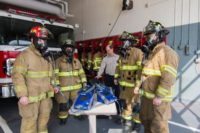
OSHA regulations (Standard 29 CFR part 1910.134) require employers to provide appropriate respiratory protection equipment when engineering control measures are not feasible or do not completely control the identified hazards. How can you be sure your company’s respirators are offering adequate protection against inhalation hazards such as toxic vapors, gases and airborne particulate substances?
Select the right respirator
Respirators are categorized into two types: tight-fitting and loose-fitting.
Tight-fitting respirators are made from many different materials including elastomeric materials that are considered reusable. They also incorporate a variety of design elements to address varying face shapes and sizes. Tight-fitting half masks cover the mouth and nose; full facepiece masks cover the entire face from hairline to below the chin. Some tight-fitting respirators are air-purifying filtering facepiece respirators (FFR), also known as disposable particulate respirators.
Regardless of the type of tight-fitting respirator, a wearer must be certain of a proper fit and face seal prior to use. A tight-fitting respirator will only protect the user if a proper fit is obtained.
On the other hand, loose-fitting facepieces, such as hoods or helmets, cover the head completely. They do not require fit testing because the air is supplied under positive pressure.
OSHA fit-test standards
OSHA standards mandate that a respirator used for an occupational purpose must be NIOSH 42.CFR 84-approved. OSHA also provides requirements and procedures for fit testing as well as standards for a respirator-protection program.
To ensure a proper fit, a series of respirator-selection and fit-testing protocols are required. Per OSHA, “The test subject shall be allowed to pick the most acceptable respirator from a sufficient number of respirator models and sizes so that the respirator is acceptable to, and correctly fits, the user.”
There are a variety of design elements to consider when offering an employee a respirator. These features include multi-flange face seals, the respirator shape, the different materials used in manufacturing the respirator (filtering facepiece, silicone, elastomeric, etc.), the types of head suspensions and cradles, and multiple adjustment points. These attributes are all factors in assuring a comfortable yet functional fit.
Fit testing is required prior to initial use and at least annually for all employees who are required to wear respirators with a tight-fitting facepiece. OSHA also has some substance-specific standards that require fit testing more frequently. This applies to air-purifying respirators, powered air-purifying respirators and atmosphere-supplying respirators. Users with facial hair must use a loose-fitting respirator.
Passing a fit test does not guarantee that every time a wearer dons a facepiece, an adequate fit will be achieved. It merely confirms that a particular facepiece has the potential to provide a sufficient fit. The wearer must always fit the mask correctly and perform the appropriate fit-check procedures provided in the manufacturer’s user instructions prior to each donning. Dental or face altering procedures, weight changes and changes in facial hair make it necessary for a new fit test be performed.
Quantitative and qualitative fit testing
Per OSHA 29 CFR 1910, there are two methods of fit testing: quantitative and qualitative.
Quantitative fit testing (QNFT) provides a numeric measure of facepiece leakage using two types of systems: ambient aerosol systems and controlled negative pressure (CNP) systems. Ambient aerosol systems calculate a respirator fit factor by measuring ambient air particles inside and outside the facepiece. CNP systems determine the leakage of a face seal under negative pressure.
Qualitative fit testing (QLFT) is based on an individual’s sensitivity to taste, smell, or irritation. The test agents allowed by OSHA include Bitrex®, isoamyl acetate (banana oil), saccharin, and stannic chloride (irritant smoke). The tests involve introducing a test agent to the user while he or she is wearing a tight-fitting facepiece respirator. A non-numeric pass or fail result is given at the conclusion of the test.
Keep your workforce informed
There are many fit-testing tools available on the market today. Multi-lingual fit-test videos are available for training purposes. Donning and fit-check posters should be posted throughout the work area to be used in conjunction with the manufacture’s instructions.



